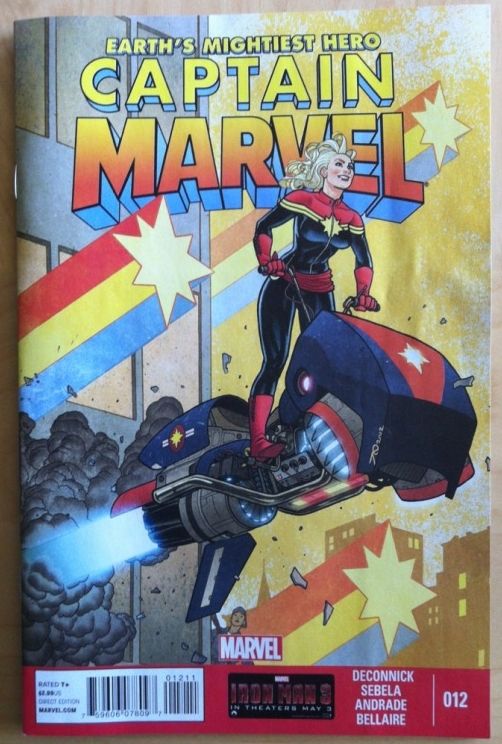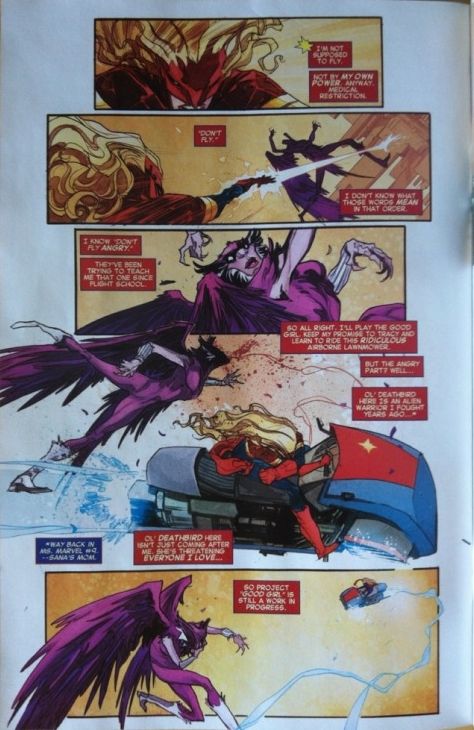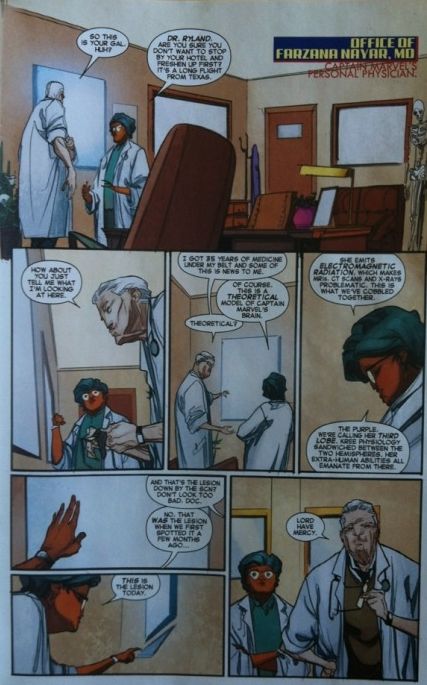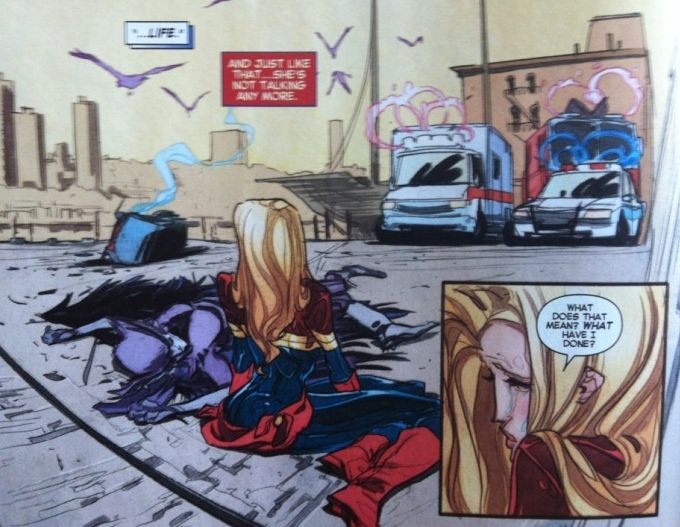This one has *SPOILERS*, particularly if you are reading Captain Marvel in trades, so read at your own risk.
My original plan was to write something short and punchy about how Filipe Andrade uses anatomy to create the impression of speed and movement in Captain Marvel. But the more I looked at the comic, the more I realized that there was something cool going on in the way the comic is structured and that to enforce that structure, a bunch of really nifty techniques were being used by the creative team.
Captain Marvel #12 continues the ongoing narrative about a grounded by illness Captain Marvel trying to defeat a winged assailant, negotiate her Super Heroics without flying, and follow her doctors orders. And doing none of those things particularly well. To tell this story, broadly speaking, Captain Marvel #12 splits itself between two narrative lines: the Superheroic and the mundane. And the way these two sections of story are established and contrasted is pretty interesting.
The Superheroic part of Captain Marvel #12 is pure, unadulterated cape comic excess. Captain Marvel fights Deathbird in an issue long grudge match while riding a "ridiculous airborne lawnmower". It's a fight that takes place almost entirely in the skies over Manhattan and involves all of the brutality, gleeful disregard for physics, and quippy trash talk the genre demands. Basically, it feels like the fantastical ideal of Superhero comics. It's saccharine and it's great.
It is also meticulously crafted. Every layer of craft in this section is devised to advance and establish this as fantasy. From a plot perspective the entire fight scene takes place in the air, a realm inaccessible to mundane people. The script is over-the-top and campy, in that classic superhero way, including amazing lines like "I'm not flying angry...I'm falling pissed off!" and "Finally found a use for that [Jetbike] I can get behind...A BASEBALL BAT!/You gonna talk now, Bird, or am I going for a Grand Slam." From an art perspective the fight scene takes place in a largely backgroundless void (little sense of place) and features figures whose bodies contort in exaggerated poses and stretch in unnatural ways. This gives these scenes a dreamlike, surreal feeling that further rejects the rules of mundane life. Even the colours work towards this effect: Captain Marvel and Deathbird have bright primary coloured costumes and fight on a background of an uncanny orangey-golden-glow. Basically, this entire section sounds and looks and feels like a Superheroic dream.
All of that Superheroism contrasts with Captain Marvel #12's mundane medical scenes. In this half of the comic, Carol's Personal Physician Dr. Nayar has a consultation with a Dr. Ryland about the lesion in Carol Danvers' brain. They meet in a doctors office, and have a calm professional discussion about what to do about her ailment. It's a solid portrayal of medicine as the gray vaguely-bureaucratic machine that sees trained professionals make informed decisions about the treatment for sick people. Which, despite the exotic nature of Carol's brain lesion, is such a profoundly mundane human problem: we are alive and therefore sometimes we get sick and this limits us. And for what it is, this section of the comic is great.
When contrasted with the Supeheroic portions of the comic from a craft perspective, this section of the comic is brilliant. The plot of this section breaks down to two doctors discussing a patients ailment, and the dialogue makes brilliant use of jargon-jargon-jargon to ground everything in the mundane rules of reality and Science. Furthermore, this scene takes place entirely in a doctors office or hospital with a meticulously dawn background that firmly establishes this scene with a realistic sense of place. The rest of the artwork also works towards this: characters are drawn with realistic proportions and anatomy and thoughtfully bored expressions, while the colours are familiar earth-tones with a hint of pastels. It's a portion of the comic that sounds, and looks, and feels like a real place and situation. It is, in many ways, the very opposite of Superhero comics.
Together these two sections work to create, what I think, is the thematic core of Captain Marvel #12. By so starkly contrasting the fantasy elements of the story with the mundane, inescapable reality of the medical establishment, the comic creates a tension between the dream (Captain Marvel fighting through the skies) and the reality (Carol Danvers is sick). And as the comic ends and the fantasy of Captain Marvels sky combat collides with the reality of her illness, that tension is resolved by the fact that our biology, our reality can't be escaped by wishing. And in that, I think, is the theme of this comic: our dreams are ultimately beholden to, and perhaps limited by, reality. It's a poignant idea, executed brilliantly by all involved.




No comments:
Post a Comment